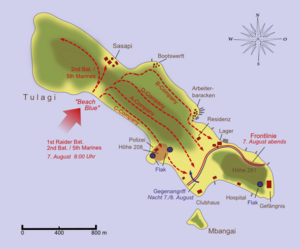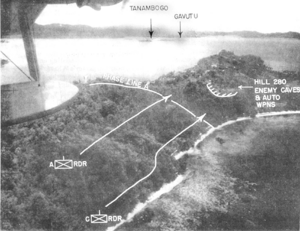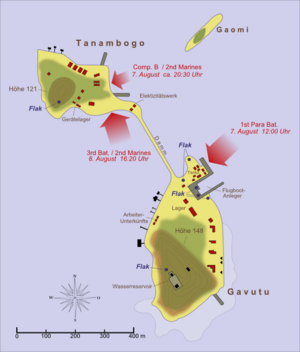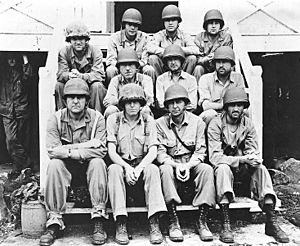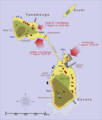Battle of Tulagi and Gavutu–Tanambogo facts for kids
Quick facts for kids Battle of Tulagi and Gavutu–Tanambogo |
|||||||
|---|---|---|---|---|---|---|---|
| Part of the Pacific Theater of World War II | |||||||
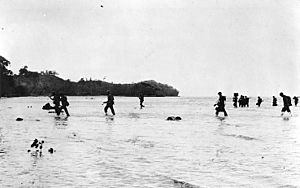 United States Marines wade ashore on Tulagi Island on 7 August 1942. |
|||||||
|
|||||||
| Belligerents | |||||||
| Commanders and leaders | |||||||
| Strength | |||||||
| 7,500 | 1,500 | ||||||
| Casualties and losses | |||||||
| 248 dead | 1,500 dead 23 captured |
||||||
The Battle of Tulagi and Gavutu–Tanambogo was an important land battle during World War II. It was fought in the Solomon Islands between the Imperial Japanese Navy and the Allied forces, mainly the United States Marine Corps. This battle took place from August 7 to 9, 1942. It was part of the first Allied landings in the Guadalcanal campaign.
U.S. Marines, led by Major General Alexander Vandegrift, attacked the islands of Tulagi, Gavutu, and Tanambogo. The Japanese Navy had built a naval and seaplane base there. The Japanese troops fought very hard. They were greatly outnumbered by the Allied forces. Most of them fought until they died.
At the same time, Allied troops were also landing on nearby Guadalcanal. Their goal was to capture an airfield the Japanese were building. Unlike the fierce fighting on Tulagi, the landings on Guadalcanal faced almost no resistance. These landings on both Tulagi and Guadalcanal started the six-month-long Guadalcanal campaign. This campaign involved many battles between Allied and Japanese forces in the Solomon Islands.
Contents
Why the Battle Happened
The Start of the Pacific War
On December 7, 1941, Japan attacked the U.S. fleet at Pearl Harbor in Hawaii. This attack started the war between the two nations. Japan's main goals were to weaken the U.S. fleet and take control of areas rich in natural resources. They also wanted to set up military bases to protect their empire. Japanese forces quickly took over many places. These included the Philippines, Singapore, and the Dutch East Indies.
Allies Fight Back
The Japanese tried to expand their control in the Pacific. But the Allies stopped them in two major battles. These were the Battle of the Coral Sea in May 1942 and the Battle of Midway in June 1942. These victories gave the Allies a chance to go on offense. They decided to attack the Japanese in the Solomon Islands. Specifically, they chose Guadalcanal, Tulagi, and Florida Island.
Japanese Bases in the Solomons
As part of an earlier plan, the Japanese Navy had occupied Tulagi and nearby islands in May 1942. These troops built a seaplane base, a ship refueling station, and a communications base. These bases were on Tulagi, Gavutu, Tanambogo, and Florida Island. They were soon ready for use.
In July, the Allies became worried. The Japanese Navy started building a large airfield on nearby Guadalcanal. By August, Japan had about 900 troops on Tulagi and nearby islands. They also had 2,800 workers on Guadalcanal. This airfield would protect Japan's main base at Rabaul. It would also threaten Allied supply routes.
The Allied Plan: Operation Watchtower
U.S. Admiral Ernest J. King came up with the plan to attack the southern Solomons. He wanted to stop Japan from using these islands as bases. This would protect the supply routes between the U.S. and Australia. He also wanted to use them as a starting point to capture the Japanese base at Rabaul.
U.S. Admiral Chester W. Nimitz was the Allied commander for Pacific forces. He put U.S. Vice Admiral Robert L. Ghormley in charge of the offensive. In May, U.S. Major General Alexander Vandegrift moved his 1st Marine Division to New Zealand. Other Allied units went to bases in Fiji, Samoa, and New Caledonia. Espiritu Santo was chosen as the main base for the attack. This attack was called Operation Watchtower. It was set to begin on August 7.
At first, the plan was only for Tulagi and the Santa Cruz Islands. But when the Allies found out about the airfield on Guadalcanal, capturing it was added to the plan. The Santa Cruz operation was then dropped. The Allied force for Operation Watchtower had 75 warships and transport ships. They practiced a landing near Fiji on July 26. Vandegrift was in charge of the 16,000 Allied ground forces. Brigadier General William H. Rupertus commanded the 3,000 U.S. Marines who would land on Tulagi and nearby islands.
Getting Ready for Battle
Bad weather helped the Allied force arrive near Guadalcanal unseen on August 7. The Japanese detected radio signals from the Allied ships. They prepared to send scout planes at daybreak. The Allied ships split into two groups. One group went to Guadalcanal, and the other went to Tulagi, Florida, and Gavutu–Tanambogo.
Planes from the aircraft carrier USS Wasp attacked Japanese bases. They dive-bombed installations on Tulagi, Gavutu, Tanambogo, and Florida. They also destroyed 15 Japanese seaplanes. Many of these planes were getting ready to take off. Their crews and support staff were lost.
The cruiser USS San Juan and destroyers Monssen and Buchanan fired at the planned landing sites. To help the attacks on Tulagi, Gavutu, and Tanambogo, U.S. Marines landed on Florida Island. They faced no resistance. Australians who knew the area helped guide them.
The Battle Begins
Fighting on Tulagi
At 8:00 AM on August 7, two groups of U.S. Marines landed on Tulagi. These were the 1st Raider Battalion and the 2nd Battalion, 5th Marines. They landed on the western side of the island. Coral reefs kept their landing craft from reaching the shore. But the Marines were able to wade the last 100 meters. The Japanese seemed surprised and did not resist at first.
The Japanese forces on Tulagi and Gavutu were from the 3rd Kure Special Naval Landing Force. Their commander, Captain Shigetoshi Miyazaki, sent a message to his leader. He said they were under attack and would "defend to the last man." The Japanese commander, Masaaki Suzuki, ordered his troops into their prepared defenses.
Marines quickly secured the northwest end of Tulagi. They then moved towards the southeast. They fought through small groups of Japanese resistance. Around noon, Suzuki moved his main defenses to a hill called Hill 281. This hill was at the southeast end of the island. The Japanese had many caves dug into the hill. They also had machine gun positions protected by sandbags. The Marines reached these defenses near sunset. They decided to stop for the night because it was getting dark.
During the night, the Japanese attacked the Marine lines five times. These attacks started at 10:30 PM. They charged forward and tried to sneak into the Marine positions. Sometimes, this led to hand to hand combat. The Japanese briefly broke through the Marine lines. But they were quickly pushed back. The Marines held their positions all night. The Japanese suffered heavy losses. One Marine, Edward H. Ahrens, killed 13 Japanese attackers before he was killed.
On August 8, six Japanese soldiers hiding under a porch killed three Marines. Other Marines quickly killed the six Japanese. Later that morning, more Marines arrived. They surrounded Hill 281 and the nearby ravine. They fired mortars at the Japanese positions. Then, they attacked. They used explosives to destroy the Japanese in their caves and fighting spots. Most Japanese resistance ended by the afternoon. A few remaining soldiers were found and killed over the next few days. In the battle for Tulagi, 307 Japanese and 45 U.S. troops died. Only three Japanese soldiers were captured.
Fighting on Gavutu–Tanambogo
The nearby islands of Gavutu and Tanambogo held the Japanese seaplane base. About 536 Japanese naval personnel were there. There were also Korean and Japanese workers. The two islands were small hills, about 42 meters high. They were connected by a 500-meter-long bridge. The Japanese had strong bunkers and caves on both hills. Each island could also fire machine guns at the other. The U.S. thought there were only 200 Japanese soldiers and workers there.
At 12:00 PM on August 7, the U.S. Marine 1st Parachute Battalion attacked Gavutu. There were 397 men. The attack was set for noon because there were not enough planes to cover all the landings at once. Naval gunfire had damaged the seaplane ramp. This forced the Marines to land in a more open spot. Japanese machine gun fire caused many casualties. One out of ten Marines was killed or wounded as they tried to get inland.
The surviving Marines set up machine guns. This helped them fire back at the Japanese. More Marines were able to move inland. Captain George Stallings ordered Marines to fire at Japanese machine gun positions on Tanambogo. Soon after, American planes dropped bombs on Tanambogo. This reduced the Japanese fire.
After about two hours, Marines reached and climbed Hill 148 on Gavutu. From the top, they began clearing Japanese positions. They used explosives, grenades, and fought hand-to-hand. From the hill, they could also fire more effectively at Tanambogo. The Marine commander asked for more troops before attacking Tanambogo.
Most of the 240 Japanese defenders on Tanambogo were aircrew and maintenance staff. Many were not trained for combat. One captured Japanese soldier said he fought with only hand sickles and poles. General Rupertus sent one company of Marines from Florida Island to help attack Tanambogo. He thought Tanambogo was only lightly defended. This company tried to land directly on Tanambogo after dark on August 7. Fires from U.S. naval shelling lit up the island. The landing craft carrying the Marines were hit by heavy fire. Many U.S. Navy boat crews were killed or wounded. Three boats were badly damaged. The Marine commander realized it was too dangerous. He ordered the remaining boats to leave with the wounded. He and 12 men who had landed ran across the bridge to safety on Gavutu. The Japanese on Tanambogo lost 10 men that day.
Throughout the night, the Japanese attacked the Marines on Gavutu. There were heavy thunderstorms. Vandegrift prepared to send more troops to Tanambogo. The 3rd Battalion, 2nd Marines (3/2) was ordered to attack Tanambogo on August 8.
The 3/2 Marines landed on Gavutu at 10:00 AM on August 8. They helped destroy the remaining Japanese defenses there. This was finished by 12:00 PM. Then, 3/2 prepared to attack Tanambogo. Marines on Gavutu provided covering fire. U.S. planes and naval ships were asked to bomb Tanambogo. Carrier planes accidentally dropped bombs on U.S. Marines on Gavutu twice, killing four of them. So, further air support was canceled. However, the San Juan shelled Tanambogo for 30 minutes.
The Marine attack began at 4:15 PM. They landed by boat and also crossed the bridge. Two Marine Stuart light tanks helped them. One tank got stuck. About 50 Japanese airmen surrounded it. They set fire to the tank, killing two crew members. They also badly hurt the other two. Marines then killed most of the Japanese. Later, 42 Japanese bodies were found around the burned tank. This included a Japanese officer and several seaplane pilots. The Japanese commander on Tanambogo, Captain Miyazaki, blew himself up in his dugout.
Throughout the day, Marines systematically blew up the caves. Most were destroyed by 9:00 PM. A few surviving Japanese launched isolated attacks during the night. There were more hand-to-hand fights. By noon on August 9, all Japanese resistance on Tanambogo ended. In the battle for Gavutu and Tanambogo, 476 Japanese and 70 U.S. Marines or naval personnel died. Most of the 20 Japanese prisoners were actually Korean workers, not combat soldiers.
Landings on Guadalcanal
The landings on Guadalcanal were much easier. At 9:10 AM on August 7, General Vandegrift and 11,000 U.S. Marines landed on Guadalcanal. They faced no resistance except for thick rainforest. They stopped for the night about 1,000 meters from the Lunga Point airfield. The next day, they reached the Lunga River and secured the airfield by 4:00 PM on August 8. The Japanese construction units had left the airfield. They left behind food, supplies, and working equipment.
What Happened After
About 80 Japanese soldiers escaped from Tulagi and Gavutu–Tanambogo. They swam to Florida Island. But Marine and British Solomon Islands patrols hunted them down. All were killed over the next two months.
The Allies quickly turned Tulagi's harbor into a naval base. It became a refueling station. During the Guadalcanal campaign and Solomon Islands campaign, Tulagi was a very important base for Allied ships. Japanese ships controlled the nearby seas at night. So, Allied ships often hid in Tulagi's harbor at night. Allied ships damaged in battles near Guadalcanal also came to Tulagi for quick repairs.
Later in the campaign, Tulagi became a base for U.S. PT boats. These small boats tried to stop Japanese supply missions to Guadalcanal. A seaplane base was also set up on nearby Florida Island.
Most of the U.S. Marines who fought on Tulagi were moved to Guadalcanal. They helped defend the airfield there. The airfield was later called Henderson Field.
The U.S. Navy escort carrier USS Tulagi, which served from 1943 to 1946, was named after the fighting on Tulagi.
Images for kids




